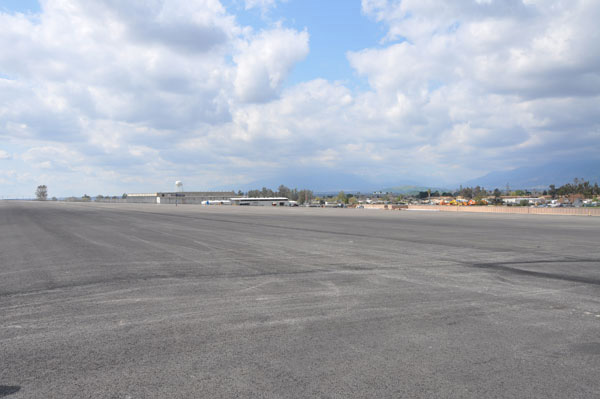 |
| The Air Force applied a protective soil cap to the former landfill, approximately 20 acres large, as part of the cleanup at the former Norton Air Force Base. Later the site was paved by the Local Redevelopment Authority for use as a parking lot. |
| Download HiRes |
The Air Force's successful cleanup of environmental contamination at the former Norton Air Force Base began decades ago and essentially ended last year. The Air Force initiated the Installation Restoration Program (IRP) at Norton Air Force Base in 1982, long before the base closed. During the 1980s, Air Force investigations determined where chemical waste disposal activities had occurred and where the groundwater contained detectable levels of solvents, primarily trichloroethene (TCE), which was used at Norton for cleaning aircraft parts from the 1940s through the 1980s.
The U.S. Environmental Protection Agency (EPA) placed Norton on the National Priorities List in 1987, under the Comprehensive Environmental Response, Compensation and Liability Act (CERCLA), due to detection of solvents in the groundwater.
To aid in developing a long-term cleanup plan, Norton was divided into three operable units (OUs,) which became two OUs in 1998, when OU2 and OU3 were combined to form what's known as the Basewide OU. OU1 is known as Central Base Area.
A Record of Decision (ROD) formalizing the cleanup plan for TCE-contaminated groundwater and the primary TCE source areas in OU1, the Central Base Area, was signed in 1993. Pump and treat systems, designed and built in 1992 and in 1995, operated until 2001 and 2002, treating approximately 6.9 billion gallons of water and removing nearly 467 pounds of TCE from the local groundwater. The pump and treat systems were turned off when the BRAC Cleanup Team determined that pumping and treating was no longer an effective remedy for TCE. The pump and treat systems were decommissioned in 2005. The primary TCE source areas, which included IRP Site 9 (the electroplating shop) and other soil contamination areas located within the Central Base Area, were addressed by the removal of facilities, excavation and treatment for shallow soil contamination, and soil vapor extraction to remove TCE from deep soil. These actions were completed by 1998.
The Air Force continues to routinely sample groundwater monitoring wells to ensure protection of human health and the environment. As of 2018, there were no remaining contaminants from the former Norton AFB that exceeded safe drinking water levels in the regional groundwater.
The Basewide OU ROD, signed in 2005, included 21 of 22 IRP sites, 73 areas of concern (AOCs), the Small Arms Range, a spill area at Building 752, and groundwater in the Northeast Base Area. About 75 percent of these did not pose an adverse risk to human health or the environment for unrestricted use and were recommended for no remedial action. Appropriate remedial actions implemented by the Air Force on the other sites included removal of approximately 20,900 tons of contaminated soil from industrial waste lagoons, applying a protective soil cap to the former landfill, and removing about 22,600 pounds of petroleum hydrocarbons from a former fire training area using a soil vapor extraction system. All remedial actions for Basewide sites had been completed by 2014.
Five-year CERCLA reviews were conducted by the Air Force in 1999, 2005, 2010 and 2015 to evaluate if the selected remedies are functioning as intended and remain protective of human health and the environment. The 2010 review noted that there are no longer any groundwater contaminant plumes on the former Norton AFB. Another indication of success is that since 1996, over 300 monitoring wells have been decommissioned as the BRAC Cleanup Team decided they were no longer needed. The 2015 Five Year Review concluded, and EPA concurred, that the Central Base Area and Basewide remedies remain protective. The Review recommended further actions for the former Small Arms Range site to ensure long-term protectiveness of the remedy. In October 2019, three small lead-impacted areas were removed to ensure long-term protectiveness of the remedy.
The former Norton AFB has been transferred by the Air Force Real Property Agency to the Inland Valley Development Agency and other entities for redevelopment. In some cases, these transfers are accompanied by deed restrictions that run with the land. For example, groundwater restrictions prevent the installation of drinking water wells in areas where cleanup standards are exceeded. In other cases, soil management plans must be submitted and approved prior to any construction or soil disturbance and certain property uses -- such as construction of residences, hospitals, day care centers, and schools for children under age 18 - are prohibited.
By 2011, all active cleanup operations at the former Norton AFB had been completed. Remaining sites were either going through the closure process (to certify completion) or were being monitored and maintained as required by environmental laws.